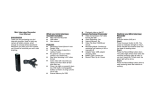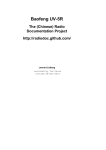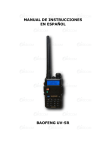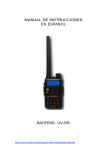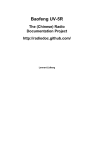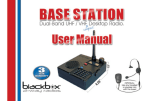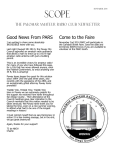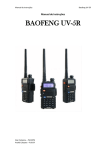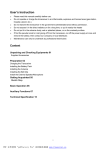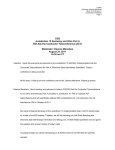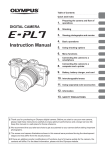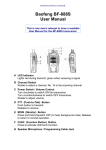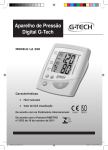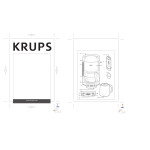Download PDF - Albuquerque International Balloon Fiesta
Transcript
DUAL BAND/DUAL DISPLAY RADIO OPERATING MANUAL UV-82 http://www.baofengradio.us 2 PREFACE Thank you for purchasing the UV-82 Amateur Portable Radio from Baofeng Radio US, the official Baofeng distributor in the United States. The UV-82 is a dual band/dual display radio made to combine extensive functionality with unmatched reliability. This intuitive radio will help you deliver secure, instant, and reliable communications with utmost efficiency. Please read this manual carefully before you use the device. The information presented herein will help you maximize the functionality and performance of your radio. http://baofengradio.us http://www.baofengradio.us 3 LICENSE/LEGAL INFORMATION This work is licensed under the Creative Commons Attribution-ShareAlike 3.0 United States License. To view a copy of this license, visit http://creativecommons.org/licenses/by-sa/3.0/us/ or send a letter to Creative Commons, PO Box 1866, Mountain View, CA 94042, USA. A summary of the license is below: You are free to: Share — copy and redistribute the material in any medium or format Adapt — remix, transform, and build upon the material, for any purpose, even commercially. Under the following conditions: Attribution — you must give appropriate credit, provide a link to the license, and indicate if changes were made. You may do so in any reasonable manner, but not in any way that suggests the licensor endorses you or your use. ShareAlike — if you remix, transform, or build upon the material, you must distribute your contributions under the same license as the original. No additional restrictions — you may not apply legal terms or technological measures that legally restrict others from doing anything the license permits. http://baofengradio.us http://www.baofengradio.us 4 Table of Contents Preface ................................................................................................................................................................................................ 2 License/Legal Information .................................................................................................................................................................. 3 Safety Information .............................................................................................................................................................................. 7 Features and Functions ....................................................................................................................................................................... 8 Getting Started.................................................................................................................................................................................... 9 Initial Setup ..................................................................................................................................................................................... 9 What’s In the Box ........................................................................................................................................................................ 9 Assembly ................................................................................................................................................................................... 10 Charging and Battery Maintenance .......................................................................................................................................... 12 Getting to Know the Radio ............................................................................................................................................................ 14 Radio Overview ......................................................................................................................................................................... 14 The Main Display ....................................................................................................................................................................... 15 Battery Level Indicator .............................................................................................................................................................. 16 Status LED ................................................................................................................................................................................. 16 Side Button 1 – Call (Broadcast FM and alarm) ........................................................................................................................ 16 Side Button 2 – MONI (Monitor and Flashlight) ....................................................................................................................... 16 VFO / MR – Mode Button ............................................................................................................. Error! Bookmark not defined. A / B – Select Button ..................................................................................................................... Error! Bookmark not defined. Numeric Keypad ........................................................................................................................................................................ 17 Accessory Jack ........................................................................................................................................................................... 18 Basic Use ....................................................................................................................................................................................... 19 Power and Volume .................................................................................................................................................................... 19 http://baofengradio.us http://www.baofengradio.us 5 Making a Call ............................................................................................................................................................................. 20 Channel Selection ..................................................................................................................................................................... 20 Advanced Topics ............................................................................................................................................................................... 23 Using the Menu System Basic Use ...................................................................................................................................... 23 Using Shortcuts ......................................................................................................................................................................... 23 Scanning ........................................................................................................................................................................................ 24 Scanning Modes ........................................................................................................................................................................ 24 Tone Scanning ........................................................................................................................................................................... 25 Dual Watch / Dual Reception ........................................................................................................................................................ 26 DTMF ............................................................................................................................................................................................. 27 Selective Calling ............................................................................................................................................................................ 28 CTCSS ........................................................................................................................................................................................ 29 DCS ............................................................................................................................................................................................ 30 1750Hz Tone Burst .................................................................................................................................................................... 30 Customization ............................................................................................................................................................................... 31 Display ....................................................................................................................................................................................... 31 Power-On Message ................................................................................................................................................................... 32 Programming ................................................................................................................................................................................ 33 Manual Programming ............................................................................................................................................................... 33 Computer Programming ........................................................................................................................................................... 35 Radio to Radio Cloning .............................................................................................................................................................. 37 How-To and Setup Guides ................................................................................................................................................................ 38 Repeaters ...................................................................................................................................................................................... 38 http://baofengradio.us http://www.baofengradio.us 6 Automatic Number Identification (ANI) ........................................................................................................................................ 39 Application Specific Setup ............................................................................................................................................................. 40 Commercial Radio Setup ........................................................................................................................................................... 40 Amateur Radio Setup ................................................................................................................................................................ 40 Troubleshooting Guide ..................................................................................................................................................................... 41 Menu Function and Description Chart .............................................................................................................................................. 42 Menu Definitions .............................................................................................................................................................................. 45 Technical Specifications .................................................................................................................................................................... 67 GENERAL ....................................................................................................................................................................................... 67 TRANSMITTER ............................................................................................................................................................................... 68 RECIEVER ....................................................................................................................................................................................... 68 DCS Table ...................................................................................................................................................................................... 69 CTCSS Table ................................................................................................................................................................................... 70 WARRANTY CERTIFICATE .................................................................................................................................................................. 71 Sources .............................................................................................................................................................................................. 73 Related Products ............................................................................................................................................................................... 74 Foscam .......................................................................................................................................................................................... 74 Amcrest ......................................................................................................................................................................................... 74 Accumed ....................................................................................................................................................................................... 74 http://baofengradio.us http://www.baofengradio.us 7 Safety Information The following safety precautions should always be observed during operation, service, and repair of this device: This device should be serviced by qualified technicians only. Do not modify or alter the radio for any reason. Use only BAOFENG supplied or BAOFENG approved batteries and chargers. Do not use a radio that has a damaged antenna. Contact with a damaged antenna may result in a minor burn. Turn off the radio prior to entering any area with explosive and/or flammable materials. Do not charge the battery in a location containing explosive and/or flammable materials. Avoid electromagnetic interference and/or compatibility conflicts by turning off the radio in any area where posted notices instruct you to do so. Turn off the radio prior to boarding an aircraft. Any use of a radio within an aircraft must be in accordance with airline regulations or crew instructions. Turn off the radio prior to entering a blast area. For vehicles with air bags, do not place the radio on the air bag deployment area. Do not expose the radio to direct sunlight for extended periods of time, nor place it close to any source of heat. When transmitting, hold the radio vertically with the microphone 3 to 4 centimeters away from your lips. Keep the antenna at least 2.5 centimeters away from your body when transmitting. http://baofengradio.us http://www.baofengradio.us Features and Functions Below are some of the major features and functions of the UV-82 portable radio: Dual-band handheld transceiver with display LCD DTMF encoding Commercial FM radio receiver Allows storage of up to 105 programmable DCS codes and 50 CTCSS privacy codes Allows storage of up to 128 memory channels Voice Operated Transmission (VOX) functionality Alarm functionality Allows selection between Broadband (Wide) & Narrowband (Narrow) modes Allows user to toggle between High and Low power consumption modes (5W vs 1W) Display illumination and programmable keypad Function that causes keypad button presses to emit a beeping sound Dual Watch & Dual Reception Selectable Frequency Steps (2.5/5/6.25/10/12.5/20/25/50 kHz) Frequency offset functionality for repeater access Battery saving functionality Programmable timer transmission Frequency scan mode functionality Function Busy Channel Lock Built-in RX CTCSS/DCS scan Built-in LED flashlight Allows for PC programmability through use of USB cable (optional accessory) Level Threshold Squelch adjustability Cross band reception/transmission End of Transmission Tone functionality Built-in keypad lock http://baofengradio.us 8 http://www.baofengradio.us 9 Getting Started Initial Setup What’s In the Box This radio comes shipped with the following items in the box: Radio Body Antenna Wrist Strap Lithium-Ion Battery Pack Lapel Microphone Charging Cable & Adapter Charging Stand Belt Clip User Manual Optional Accessories Car Charging Cable & Adapter Speaker Microphone Attachment http://baofengradio.us USB Connecting Cable http://www.baofengradio.us Assembly Antenna This device is fitted with a Male SMA connector. To mount the antenna (Female SMA Connector), align the two connectors and turn the antenna clockwise until it stops. When installing the antenna, install it by holding the base and turning. If an external antenna is used, ensure that the ‘SWR’ is about 1.5:1 or less to avoid damage to the transceiver's transistors. Holding the antenna with your hand or wrapping the outside may cause subpar operation of the transceiver. Never transmit from the device without an antenna. Belt Clip On the back of the radio, above the battery, there are two parallel screws. Remove these and align them so that they go through the holes on the belt clip as they are screwed back into the radio body to securely affix the belt clip. Install the belt clip at the rear of the battery compartment cover as shown in the figure to the right. Do not use glue to affix the screws onto the battery clip. Application of glue may cause damage to the casing of the battery. http://baofengradio.us 10 http://www.baofengradio.us Battery Before attaching or removing the battery make sure the radio is turned off by turning the power/volume knob all the way counter-clockwise. Installation To attach the battery, ensure the battery is parallel and in good contact with the aluminum chassis. The battery bottom is about 1 to 2 centimeters below the bottom of the radio’s body. Align the battery with the guide rails on the radio chassis and slide it upwards until it clicks into place. The battery latch at the bottom locks the battery in place. Removal Ensure the radio is off before removing the battery. To remove the battery, press the battery release above the battery pack and slide the battery downward. After sliding the battery down a few centimeters, the battery can be removed from the radio body. External Headset Plug the external micro-headset connector into the jack of ‘SP & MIC’ of the transceiver as shown in the figure on the right. http://baofengradio.us 11 http://www.baofengradio.us 12 Charging and Battery Maintenance Charging the Battery Follow the steps below to set up and use the charger: 1. Plug the end of the power adapter into the charger base. 2. Plug the power adapter into an electrical wall socket. 3. Place the radio or battery in the charging slot on the charger. 4. Make sure the contact plates of the battery are making contact with the charger. Ensure that the radio fits snugly into the dock. When the red LED stays on, the radio is charging. 5. The radio is fully charged once the LED on the charger stays green. Please remove the radio after it is fully charged to avoid over-charging the battery. Charger LED Codes Charging Status LED Indication Standby (no-load) Red LED flashes while Green LED glows Charging Red LED glows solidly Fully Charged Green LED glows solidly Error Red LED flashes while Green LED glows http://baofengradio.us http://www.baofengradio.us 13 Battery Maintenance The battery for the radio comes uncharged from the factory. Please charge it for at least four to five hours before starting to use the radio. • Use only batteries that are approved by the original manufacturer. • Never attempt to disassemble the battery pack. • Do not expose the battery to fire or intense heat. • Dispose of batteries in accordance with local recycling regulations. Prolonging the Life of the Battery • Only charge batteries in normal room temperatures. • When charging a battery attached to the radio, turn the radio off for a faster charge. • Do not unplug the power to the charger or remove the battery and/or radio before it has finished charging. • Never charge a wet battery. • Batteries wear out over time. If there is a considerably shorter operating time with the radio, please consider purchasing a new battery. • Battery performance is reduced when temperatures are below freezing. When working in cold environments, it is recommended to keep a spare battery at hand, preferably inside a jacket or in a similar location in order to keep the battery warm. • Dust can interfere with the contacts on the battery. If necessary wipe the contacts with a clean cloth to ensure proper contact with radio and charger. Storage Fully charge the battery before storing the device for a prolonged period of time in order to prevent damage from overdischarge. To avoid severe capacity degradation of the battery while in long time storage, please cycle the battery at least every six (6) months. Store the batteries in a cool and dry place, never above normal room temperatures. In Case of Exposure to Water If the battery has become wet, remove it from the radio, dry with a towel, and put it in a plastic bag that contains a handful of dry rice. Tie the bag up and let it sit overnight. The rice should absorb any remaining moisture in the battery. http://baofengradio.us http://www.baofengradio.us Getting to Know the Radio Radio Overview 1. Antenna 2. LCD Display 3. Keypad 4. Volume Knob (On/Off Switch) 5. Flashlight 6. Speaker 7. Microphone 8. Battery Latch 9. PTT-A (top) 10. PTT-B (bottom) 11. CALL Button 12. MONI Button 13. Strap Buckle 14. Accessory Jack 15. LED Indicator http://baofengradio.us 14 http://www.baofengradio.us The Main Display The Baofeng UV-82 Display Description Icon 188 Memory Channel 75/25 Least Significant Modifiers CT CTCSS enabled DCS DCS enabled +- Frequency Offset Shift Direction if Enabled S Dual Watch/Dual Reception if Enabled VOX VOX Function if Enabled R Reverse Function if Enabled N Narrowband Enabled Battery Level Indicator Keypad Lock Function if Enabled L Low Transmit Power Mode if Enabled ▲▼ Active Band or Channel Signal Strength Meter http://baofengradio.us 15 http://www.baofengradio.us 16 Battery Level Indicator When the battery level indicator has no black bars showing, it means the battery is close to depletion. To warn the user of this, the radio will start beeping periodically as well as flashing the backlight of the display, indicating that the battery needs to be changed. Status LED The status LED has a very simple and traditional design. When a signal is received, it turns green, when transmitting, it turns red, and is off when in standby. Side Button 1 – Call (Broadcast FM and alarm) Press [CALL] momentarily to start the broadcast FM receiver. Another momentary press turns the broadcast FM receiver off. Press and hold to [CALL] activate the alarm function. Press again to turn it off. Side Button 2 – MONI (Monitor and Flashlight) Press [MONI] momentarily to turn on the LED flashlight. Another momentary press turns the flashlight off. Press and hold [MONI] to monitor the signal. This will open up the squelch and permit listening to the unfiltered signal. http://baofengradio.us http://www.baofengradio.us 17 Numeric Keypad The Baofeng UV-82 hand-held transceiver comes standard with a full numeric keypad. The numeric buttons have their secondary function printed on them. The and buttons also have secondary functions, scan and keypad lock respectively. Pound Button In channel mode the [POUND] button also acts as a transmit power shortcut button. While in channel mode, press [POUND] to change between High and Low transmit power. Please note that the transmit power stored to memory for that channel is not altered permanently, it affects only the current session. Switching to another channel or another operating mode will reset transmit power to the setting stored in the channel’s memory. Keypad Lock The Baofeng UV-82 includes a keypad lock feature that locks out all buttons except for the three on the side of the radio. To enable or disable the keypad lock, press and hold the [POUND] button for about two seconds. Automatic keypad locking can also be enabled through the menu so that the radio automatically locks the keypad after ten seconds. Star Button A quick press of the [STAR] button enables the reverse function. When listening to broadcast FM, a momentary press will start the scanning function. Scanning in broadcast FM will stop as soon as an active station is found. To enable the scanner, press and hold the [STAR] button for two seconds. http://baofengradio.us http://www.baofengradio.us 18 Menu and Function Buttons The button is used to access the menu and to confirm menu options. The and buttons are used to navigate through the menu items, as well as to select channels, and to step up or down in frequency (depending on operating mode). The button is used to exit menus and cancel menu options. Accessory Jack The accessory jack on the Baofeng UV-82 is a Kenwood compatible two pin design. The Kenwood 2-pin connector has one 3.5mm TRS plug, and one 2.5mm TS plug, with 12mm of space in between. To attach accessories such as headsets, speaker, microphones, or USB PC cables, align the connectors and push the plugs in fully. Ensure the radio is turned off before attaching any accessories. http://baofengradio.us http://www.baofengradio.us 19 Basic Use Power and Volume Before the power is turned on, ensure that the battery and antenna are both attached, as described in the Initial Setup section. Turning the Unit On To turn the unit on, rotate the volume/power knob clockwise until a “click” sound is heard. If the radio powers on correctly, there should be an audible double beep, and the display and backlight should turn on, looking something like picture below: Turning the Unit Off Turn the volume/power knob counter-clock wise all the way until a “click” sound is heard. The unit is now off. Adjusting the Volume To turn up the volume, turn the volume/power knob clock-wise. To turn the volume down, turn the volume/power knob counter-clock-wise. Be careful not to turn the knob too far, as you may accidentally turn the radio off. A good way to adjust volume is by using the monitor function, enabled from the [MONI] button below the [PTT] button, to more accurately and easily adjust the volume by adjusting it to the un-squelched static sound. http://baofengradio.us http://www.baofengradio.us 20 Making a Call Press and hold the [PTT] button on the left side of the radio body to transmit. Hold the device’s microphone approximately 3-5 cm from your mouth while transmitting. When the PTT button is released, the device will go back to receive mode. Channel Selection There are two modes of operation on this radio: Frequency Mode (VFO) and Channel/Memory Mode (MR). Both modes are detailed below. Frequency Mode (VFO) While in Frequency Mode (VFO), navigating up and down the frequency band is done by using the [UP] and [DOWN] buttons. Each press of the button will increment or decrement the frequency according to the frequency step that has been set on the transceiver. Frequency step can be set in the menu. See the Menu Function & Description chart or the Menu Definitions section for more details. Frequencies can be input directly using the numeric keypad with kilohertz accuracy, however, the radio will round up to the nearest frequency that corresponds to the frequency step setting. For example, when a frequency is input with greater than 1kHz resolution (such as 145.6875 as shown in the example below), always round your input upwards. http://baofengradio.us http://www.baofengradio.us 21 For the following example, assume a 12.6 kHz frequency step. Entering the frequency 145.6875 MHz on Display A 1. Turn off and turn on the radio while holding the [PTT] button to switch the radio to Frequency (VFO) mode. 2. Press [PTT A] button until the black arrow appears next to the upper display (Display A). 3. Enter [1] [4] [5] on the numeric keypad, it should look something like this: 4. When entering the final four digits, note that only three decimals can be entered on the keypad. If 6875 is typed, it won’t work as the last digit is omitted. 5. By rounding 145.6875 up to 145.6880, the frequency can now be entered. 6. Enter [6] [8] [7] on the numeric keypad, it should look something like this: Note: Just because programming is enabled in a channel does not mean authorization is granted for use of that frequency. Transmitting on frequencies without authorization is illegal, and in most jurisdictions is a serious offence. If caught transmitting without a license, fines can be levied, and in some cases jailtime. However, in most jurisdictions it is legal to listen. Contact your local regulatory entity for further information on what laws, rules and regulations apply in your area. http://baofengradio.us http://www.baofengradio.us Channel Mode (MR) The use of Channel (MR) mode is dependent on having previously programmed in some channels for use. To learn how to program channels, reference Section 4, Subsection G Programming in this manual. Once the channels are programmed and ready, the [UP] and [DOWN] buttons can be used to navigate between channels. Note: If you have channels programmed with Transmit power set to Low, you can use the [POUND] button to momentarily switch over to high power if you're having trouble getting through. http://baofengradio.us 22 http://www.baofengradio.us 23 Advanced Topics For a complete reference on menu items, see section IV: Menu Definitions. Note: For radios set to Memory Mode (MR) the following menu items will not take effect: STEP, TXP, W/N, CTCSS, DCS, S-CODE, PTT-ID, BCL, SFT-D, OFFSET, MEM-CH, BAND. Using the Menu System Basic Use Procedure: Using the Menu with Arrow Buttons 1. Press the [MENU] button to enter the menu. 2. Use the [UP] and [DOWN] to navigate between menu items. 3. Once the desired menu item is found, press [MENU] again to select that menu item. 4. Use the [UP] and [DOWN] buttons to select the desired parameter. 5. When the parameter is selected you want to set for a given menu item, you can press the [MENU] button to confirm the setting or press the [EXIT] button to reset that menu item and exit the menu system. 6. To exit out of the menu at any time, press the [EXIT] button. Using Shortcuts Every menu item has a numerical value associated with it, and these numbers can be used for direct access of any given menu item. To see which numerical value is associated with each menu item, go to Section IV: Menu Definitions. The top ten most common features are also the top menu functions, and these are printed on the keypad for easy reference. Procedure: Using the Menu with Shortcuts 1. Press the [MENU] button to enter the menu. 2. Use the numerical keypad to enter the number of the menu item. 3. To enter the menu item, press the [MENU] button. 4. For entering the desired parameter, the arrow buttons can be used to scroll through options, or use the numerical shortcuts to access specific menu items. 5. When the parameter you want to set for a given menu item is selected, the [MENU] button can be pressed to confirm the setting or press the [EXIT] button to reset that menu item and exit the menu system. 6. To exit out of the menu at any time, press the [EXIT] button. http://baofengradio.us http://www.baofengradio.us 24 Scanning The Baofeng UV-82 features a built in scanner for VHF and UHF bands. When in Frequency (VFO) mode, the scanner will scan in steps according to the set frequency step. In Channel (MR) mode it will scan the saved channels. To enable the scanner, press and hold the [SCAN] button for about two seconds. Press any button to exit scanning mode. Scanning Modes The scanner is configurable to one of three ways of operation: Time, Carrier, or Search. Procedure: Setting Scanner Mode 1. Press the [MENU] button to enter the menu. 2. Enter [1] [8] on the numeric keypad to enter scanner mode. 3. Press the [MENU] button to select. 4. Use the [UP] and [DOWN] buttons to select scanning mode. 5. Press the [MENU] button to confirm and save. 6. Press the [EXIT] button to exit the menu. Time Operation In Time Operation mode (TO), the scanner stops when it detects a signal, and after a preset amount of time, it resumes scanning. Carrier Operation In Carrier Operation mode (CO), the scanner stops when it detects a signal, and resumes scanning only when the signal is lost. Search Operation In Search Operation mode (SE), the scanner stops when it detects a signal. To resume scanning during each of these modes, press and hold the [SCAN] button. http://baofengradio.us http://www.baofengradio.us 25 Tone Scanning You can scan for CTCSS tones and DCS codes on active frequencies in frequency mode. To scan for CTCSS or DCS on active channels, follow these steps: Procedure: Tone Scanning 1. Press the [MENU] button to enter the menu. 2. Enter either of the following on the numeric keypad. a. Enter [1] [0] on the numeric keypad to scan for DCS codes. b. Enter [1] [1] on the numeric keypad to scan for CTCSS sub-tones. 3. Press the [MENU] button to select. 4. Press the [SCAN] button momentarily. 5. CT or DCS will start flashing in the display as the radio starts scanning. Once it finds a tone or code in use, it will beep and stop flashing, indicating that a tone or code has been found. 6. Press the [SCAN] button to confirm. 7. Press the [EXIT] button to exit the menu. http://baofengradio.us http://www.baofengradio.us 26 Dual Watch / Dual Reception One of the unique capabilities on the Baofeng UV-82 radio is the ability to monitor two channels at once. This is accomplished by a feature in the radio known as Dual Watch, which allows the radio to switch between two frequencies at a fixed interval, despite it only containing one receiver. The Dual Watch functionality also allows the ability to lock the transmit frequency to one of the two channels it monitors. Note: While in Dual Watch mode, certain functions are not available. The below functions are disabled when Dual Watch is active. Reverse function Usage of [POUND] button to switch between high and low transmit powers in channel mode Saving of duplex channels To enable the Dual Watch function, follow the steps below: Procedure: Enabling or Disabling Dual Watch Mode 1. Press the [MENU] button to enter the menu. 2. Enter [7] on the numeric keypad to get to Dual Watch. 3. Press the [MENU] button to select. 4. Use the [UP] and [DOWN] buttons to enable or disable Dual Watch mode. 5. Press the [MENU] button to confirm. 6. Press the [EXIT] button to exit the menu. Whichever one of the A or B channels goes active first will be the default one to transmit on. This can be problematic when listening to a frequency that does not permit transmission from the device. To assist with this, there is a menu option to enable locking the transmitter to either the A or B channel, as per the selection. Please see below for steps on how to activate this: Procedure: Locking the Dual Watch Transmit Channel 1. Press the [MENU] button to enter the menu. 2. Enter [3] [4] on the numeric keypad to get to TDR-AB. 3. Press the [MENU] button to select. 4. Use the [UP] and [DOWN] buttons to select either A (upper) or B (lower) displays. 5. Press the [MENU] button to confirm. 6. Press the [EXIT] button to exit the menu. Note: To momentarily override the lock without having to setting the menu option to OFF, press the [PTT-A] or [PTT-B] button an instant before pressing the [PTT] button. http://baofengradio.us http://www.baofengradio.us 27 DTMF DTMF stands for Dual-Tone Multi-Frequency. Basically DTMF is an advanced signaling method that uses dual sinusoidal signals for any given code. A good example of DTMF in use is a touch tone telephone system. In two-way radio systems, DTMF is mainly used for automation systems and for remote control. For example, DTMF can be used to remotely activate repeaters by transmitting a specific sequence of numbers. Table: DTMF Frequencies and Corresponding Codes 1209 Hz 1336 Hz 1477 Hz 1633 Hz 697 Hz 1 2 3 A 770 Hz 4 5 6 B 852 Hz 7 8 9 C 941 Hz * 0 # D The Baofeng UV-82 allows for full implementation of DTMF. The numerical and the [SCAN] and [LOCK] buttons correspond to the matching DTMF tones. The numeric buttons correspond to the same DTMF tones, but to access the A, B, C, & D codes, the [MENU], [UP], [DOWN], and [EXIT] buttons are used, respectively. To send DTMF codes, press the buttons corresponding to the message you want to send while holding down the [PTT] button. See below for the mapping of DTMF tones to the keypad. A B C D 1 2 3 * 4 5 6 0 7 8 9 # http://baofengradio.us http://www.baofengradio.us 28 Selective Calling When working with large groups of people on the same channel, there tends to be a lot of crowding in terms of transmissions. To counteract this crowding, there are several methods of blocking out extra or unwanted transmissions. There are two forms of selective calling available in two-way radio systems: Group Calling & Individual Calling. Group calling is a one-to-many form of communication. Every radio in the working group is configured the same way and any radio will make contact with every other radio in the group. Individual calling, also known as paging, is a one-to-one form of communication. Every radio is programmed with a unique ID code, and only by sending out a matching code can you get that radio to open up to your transmissions. A good example of this is a cellular phone. The Baofeng UV-82 features three different group calling methods: • CTCSS • DCS • Tone-burst (1750Hz) The Baofeng UV-82 does not feature any form of individual calling at this time. Note: Using group calling features does NOT mean that others won't be able to listen in on your transmissions. These features only provide a way to filter out unwanted incoming transmissions. Any communications sent out while using these features will still be heard by anyone not employing filtering options of their own. http://baofengradio.us http://www.baofengradio.us CTCSS CTCSS settings are accessed from the menu with shortcuts 11 for R-CTCS and 13 for T-CTCS. For a full list of available CTCSS codes and corresponding sub-tone frequencies, see the CTCSS Table in the Technical Specifications section near the end of this manual. Procedure: Setting up CTCSS 1. Press the [MENU] button to enter the menu. 2. Enter [1] [1] on the numeric keypad to get to Receiver CTCSS (R-CTCS). 3. Press the [MENU] button to select. 4. Enter the desired CTCSS sub-tone frequency in hertz on the numeric keypad. 5. Press the [MENU] button to confirm and save. 6. Enter [1] [3] on the numeric keypad to get to Transmitter CTCSS (T-CTCS). 7. Press the [MENU] button to select. 8. Enter the desired CTCSS sub-tone frequency in hertz on the numeric keypad. 9. Press the [MENU] button to confirm and save. 10. Press the [EXIT] button to exit the menu. To turn CTCSS off, follow the same procedure but enter [0] for steps 4 and 8 instead of entering a sub-tone frequency. http://baofengradio.us 29 http://www.baofengradio.us 30 DCS DCS settings are accessed from the menu with shortcuts 10 for R-DCS and 12 for T-DCS. For a full list of available DCS codes and corresponding sub-tone frequencies, see the DCS Table in the Technical Specifications section near the end of this manual. Procedure: Setting up DCS 1. Press the [MENU] button to enter the menu. 2. Enter [1] [0] on the numeric keypad to get to Receiver DCS (R-DCS). 3. Press the [MENU] button to select. 4. Enter the desired DCS sub-tone frequency in hertz on the numeric keypad. 5. Press the [MENU] button to confirm and save. 6. Enter [1] [2] on the numeric keypad to get to Transmitter DCS (T-DCS). 7. Press the [MENU] button to select. 8. Enter the desired DCS sub-tone frequency in hertz on the numeric keypad. 9. Press the [MENU] button to confirm and save. 10. Press the [EXIT] button to exit the menu. To turn DCS off, follow the same procedure but enter [0] for steps 4 and 8 instead of entering a sub-tone frequency. 1750Hz Tone Burst To send out a 1750Hz tone burst, press the [PTT-A] or [PTT-B] button (or [BAND] button on some older models) while holding down the PTT button. This feature also works even when they keypad lock is enabled on the radio. http://baofengradio.us http://www.baofengradio.us 31 Customization The Baofeng UV-82 allows for customization of both the power-on message (via the Baofeng PC software), and the backlight color during the three states of transmission (Transmit, Receive, and Standby). Display The LCD on the Baofeng UV-82 is backlit by multi-color LEDs, the color of which can be pre-set from the menu system into a variety of colors. To change the colors, follow the steps below: Procedure: Changing the Backlight Color 1. Press the [MENU] button to enter the menu. 2. Enter one of the following on the numeric keypad: a. [2] [9] to change the Standby color. b. [3] [0] to change the Receive color. c. [3] [1] to change the Transmit color. 3. Press the [MENU] button to select. 4. Use the [UP] and [DOWN] buttons to select the desired color. 5. Press the [MENU] button to confirm and save. 6. Press the [EXIT] button to exit the menu. To change how long the backlight stays on, follow these steps: Procedure: Setting Backlight Time-Out duration 1. Press the [MENU] button to enter the menu. 2. Enter [6] on the numeric keypad to get to the Backlight Time-Out settings. 3. Press the [MENU] button to select. 4. Use the [UP] and [DOWN] buttons to increase or decrease the amount of time the backlight stays on. 5. Press the [MENU] button to confirm and save. 6. Press the [EXIT] button to exit the menu. http://baofengradio.us http://www.baofengradio.us 32 Power-On Message The power-on message can only be customized via the Baofeng PC software. For more information, see the section “Programming” for details on how to install, set-up, and use the software. The following instructions are written assuming that the Baofeng software has already been installed and is running and that the Baofeng radio is connected to the PC that is running the Baofeng software. Procedure: Setting the Power-On-Message 1. Click the “Other” button on the menu bar. This should trigger the opening of a dialog box titled “Other”. 2. In the box titled “Power On Message”, there are two text fields representing the lines on the LCD screen. Enter the desired text in the fields. 3. Click the “Write” button to write the changes to the radio. 4. On the radio itself, ensure that menu item 38 is set to MSG. Note: The UV-82 can only display 7 characters per line. http://baofengradio.us http://www.baofengradio.us 33 Programming Memory channels are a simple and efficient way to store the most commonly used frequencies so they can be quickly accessible for later use. The Baofeng UV-82 has the capability to store up to 128 memory slots that can hold any of the following information: Receive/Transmit Frequencies Transmit Power Settings Group Signaling Information Bandwidth ANI/PTT-ID Settings 6 Character Alphanumeric Channel Name Manual Programming When programming channels in VFO mode, it is important to remember that only the frequency displayed on the upper channel (A) can be saved. To create a new channel, start by switching the radio to Frequency (VFO) mode using the [VFO/MR] button. When in Frequency (VFO) mode, select the desired receive frequency using the numeric keypad. Next, use the menu system to configure any additional details for the channel that you want to store to the radio’s memory (Examples Include: Transmit Power, Bandwidth, CTCSS or DCS, etc.) For more information on how to use the Menu, see the chapter titled “Using the Menu System”. Simplex Channels To save a Simplex channel, please follow the steps below: Procedure: Saving (Programming) a Simplex Channel to Memory 1. Press the [MENU] button to enter the menu. 2. Enter [2] [7] on the numeric keypad to get to MEM-CH. 3. Press the [MENU] button to select. 4. Use the [UP] and [DOWN] buttons to select a memory channel, or enter it in directly on the numeric keypad. 5. Press the [MENU] button to confirm. Press [EXIT] to switch to Channel (MR) mode with the button to test the new channel. To name the channel, you must connect the radio with the Baofeng PC software. http://baofengradio.us http://www.baofengradio.us 34 Duplex Channels The following instructions assume that a duplex channel has been set up in VFO mode on the upper display and that VFO mode is still active. Procedure: Saving (Programming) a Duplex Channel to Memory 1. Press the [MENU] button to enter the menu. 2. Enter [2] [7] on the numeric keypad to get to MEM-CH. 3. Press the [MENU] button to select. 4. Use the [UP] and [DOWN] buttons to select a memory channel, or enter it in directly on the numeric keypad. 5. Press the [MENU] button to confirm. 6. Press the [SCAN] button to activate reverse mode. If this does not work, enter the frequency manually. 7. Enter [2] [7] on the numeric keypad to get to MEM-CH. 8. Press the [MENU] button to select. 9. Use the [UP] and [DOWN] buttons to select a memory channel, or enter it in directly on the numeric keypad. 10. Press the [MENU] button to confirm. http://baofengradio.us http://www.baofengradio.us 35 Computer Programming This section assumes that the Baofeng software is installed on your PC. Attaching the Programming Cable Ensure that the radio is off before attaching the cable. To attach the cable, uncover the accessory port behind the rubber flap on the right side of the radio body, align the connectors and push in firmly. Attach the USB connector to the computer and start the programming software, then turn on the radio. Baofeng Software Note: When first opening up the Baofeng programming software, the language may default to Chinese. To change the language to English, go to the second rightmost menu. This will open a list of available languages to select, including English. When starting the Baofeng programming software, the Channel Information window will show. This is where channel information for memory channels can be entered. If the Channel Information window doesn't appear automatically, it can be shown by going to Edit -> Channel Information. Before adding channels, go to Communication to select the port the cable is attached to. Next go to Program -> Read from Radio and click Read to read in any existing channel information on the radio. This is an effective way to test the connection of the programming cable. If the read is successful the LED on the radio will start flashing red indicating that the radio is transmitting data to the computer. http://baofengradio.us http://www.baofengradio.us Channel Information Window: Column Definitions Channel -> Channel number. Band -> Displays what Frequency Band is active. RX Frequency -> Receive Frequency. TX Frequency -> Transmit Frequency. Defaults to the Receive Frequency. CTCSS/DCS Dec -> Receiver CTCSS or DCS. Defaults to OFF. CTCSS/DCS Enc -> Transmitter CTCSS or DCS. Defaults to OFF. TX Power -> Transmit power. Defaults to HIGH. W/N -> Wideband or Narrowband operation. Defaults to W for Wideband. PTT-ID -> Enables and sets position of PTT-ID. Defaults to OFF. BusyLock -> Busy Channel Lock-out. Defaults to OFF. Scan_Add -> Add to scanner list. When enabled the channel is included in scanning mode. Defaults to ON. SigCode -> Signal Code, group ID for the channel. Defaults to 1. CH-Name -> Channel name. To add a new channel, go to the row for the channel number you want to edit and follow these steps: Procedure: Adding a Channel 1. Click in the RX Frequency field and enter the receiving frequency. 2. Click on the TX Frequency field and the rest of the row should fill automatically with default values (except for CH – Name, which will remain blank) a. 3. If adding a duplex channel, the transmit frequency can be directly entered here. Add or edit any of the information for the channel as needed. a. An optional 6-character channel name can be entered in the CH-Name field. To finalize any programming, go to Program -> Write to Radio and then click Write. If successful, the radio will start to flash green indicating that it is receiving data. When all data has been sent from the computer, the radio will restart itself. http://baofengradio.us 36 http://www.baofengradio.us 37 Radio to Radio Cloning The Baofeng UV-82 is capable of cloning between radios. This means if there is one radio configured in a certain manner, the settings can be cloned onto another radio to ensure it is exactly the same. This is done by connecting a Reference (Master) radio to a Copy (Slave) radio by hooking a cable between the two and copying the information over. Procedure: Cloning Radios 1. Attach the cloning cable to both the Reference and Copy radios by inserting the adapters into each radio’s respective accessory cable ports. 2. Turn on the Copy radio (the radio that is being cloned to). 3. Turn on the Reference radio (the radio that is being cloned from) while holding down the [MONI] button. 4. The Reference radio should show COPYING in the display, and if the connection is successful, the LED will start flashing red to indicate data transfer. The Copy radio’s LED should be flashing green at the same time to indicate that it is receiving data. 5. When the LEDs on both radios turn off, the radios will restart, and the cloning operation will be completed. http://baofengradio.us http://www.baofengradio.us 38 How-To and Setup Guides Repeaters A radio repeater is usually an automated transceiver in a specific fixed location. Mounted high up on hills, mountains, or tall buildings, repeaters take one signal and relay it, usually after amplifying it greatly. This enables usage of a small low-powered handheld two-way transceiver such as the Baofeng UV-82 to transmit to greater distances. A radio repeater is an automated transceiver (device that can transmit and receive) in a fixed location. Usually mounted high up on hill tops or on tall buildings, but sometimes they operate within buildings for internal use. A repeater takes one signal and relays it, usually after amplifying it by orders of magnitude. This can be very handy, as this enables the use of a small low powered handheld two-way transceiver such as the Baofeng UV-82 to reach great distances. A common type of repeater is the duplex repeater. A duplex repeater transmits and receives simultaneously, but on different frequencies. To utilize this specific type of repeater, the radio has to be capable of transmitting and receiving on different frequencies on the same memory channel. This kind of repeater is used by setting the receive frequency of the radio to the output frequency of the repeater, and the transmit frequency of the radio to the input frequency of the repeater. The transmit frequency may not always be explicitly stated, as many radios use a specific offset relative to the receive frequency. The Baofeng UV-82 handles repeater setup in this fashion, by specifying frequency offset rather than transmit frequency. The following instructions assume knowledge of transmit and receive frequencies that your specified repeater employs, as well as authorization to use it. http://baofengradio.us http://www.baofengradio.us 39 Automatic Number Identification (ANI) In most dispatch environments it is common to have a system that allows radios to automatically identify themselves to the dispatcher. This is known as Automatic Number Identification (AIN), or PTT-ID, due to the radio sending a data burst containing the ID code at the beginning or end of a transmission. The Baofeng UV-82 uses DTMF signaling to enable ANI implementation. Procedure: Setting ANI/PTT-ID Code 1. Attach the radio to the computer and open the Baofeng PC software. See “Computer Programming” section for more details. 2. In the Edit menu, select DTMF. This will open up a window called DTMF Encode/Decode. 3. Go to the Program menu, select Read from Radio and the Read from Radio window will open. 4. Click the Read button. The status LED on the radio will flash red indicating the transmission of data. 5. Locate the box named ANI Code and enter any relevant ANI code details into this text field. a. If group ID codes are used instead of personal ID codes, it is possible to enter up to 15 of them in the list on the left in the DTMF Encode/Decode window. These can be assigned on a channel by channel basis in the Channel Information field. 6. Check the Press PTT to Send box to transmit ID prior to regular transmission. 7. Check the Release PTT to Send box to transmit ID after regular transmission. 8. In the Program menu, select Write to Radio and the Write Data to Radio window will open. 9. Click the Write button. The status LED on the radio will flash green indicating that it’s receiving data. To fully enable ANI settings, there are a few more steps. The directions below assume that the radio is still connected to the PC, and that the software is running. Procedure: Enabling/Disables/Configuring ANI Settings 1. In the Edit menu, select Optional Features. This will open up a window called Optional Features. 2. Go to the Program menu, select Read from Radio and the Read from Radio window will open. 3. Click the Read button. The status LED on the radio will flash red indicating the transmission of data. 4. Use the PTT-ID drop-down list to select the position of both the ANI data burst; BOT (Beginning of Transmission), EOT (End of Transmission), or BOTH. To turn ANI off completely, select OFF from the drop-down list. 5. In the Program menu, select Write to Radio and the Write Data to Radio window will open. 6. Click the Write button. The status LED on the radio will flash green indicating that it’s receiving data. After these two procedures, the radio should be set up for ANI. http://baofengradio.us http://www.baofengradio.us 40 Application Specific Setup Commercial Radio Setup Follow these instructions to set the radio to Narrowband mode: 1. Press the [VFO/MR] button to enter frequency mode. 2. Press the [MENU] button to enter the menu. 3. Enter [5] on the numeric keypad. 4. Press [MENU] to select. 5. Use the [UP] and [DOWN] buttons to select between Wide and Narrow bands. 6. Press the [MENU] button to confirm and save. 7. Press the [EXIT] button to exit the menu. Amateur Radio Setup In contrast with Commercial radio operators, who often need very specific requirements to be compatible with a very specific radio implementation, amateur radio operators tend to need the broadest possible settings in order to be compatible with as many systems as possible. This basically implies turning off all the extraneous features that you typically might need for a commercial setup. In a typical Amateur radio setup the following settings would be recommended: • Set bandwidth to Wide (menu item 5). • Turn DCS and CTCSS off (menu items 10 through 13). • Turn ANI, DTMFST, S-CODE, PTT-ID off and PTT-LT to 0ms (menu items 15 through 17 and 19 through 20). • Turn off Squelch Tail Elimination (STE) features (menu items 35 through 37). • Turn roger beep (ROGER) off (menu item 39). http://baofengradio.us http://www.baofengradio.us 41 Troubleshooting Guide Problem Possible Cause / Solution The radio does not start. The battery may be low. Either replace the battery with a charged battery or proceed to charge the battery. The battery may not be installed correctly. Try removing the battery and reattaching it. The battery is draining quickly. Ensure the battery is fully charged before use. If the battery continues to drain at a quick pace, its life may have come to an end and it may need replacing. The receiving indicator LED lights up but the Make sure the volume setting isn’t too low by turning the knob up further. speaker is not emitting any sound. If there is still no sound, ensure that the CTCSS undertones or the DCS codes are programmed to be the same as the other people you are trying to communicate with. While transmitting, other people are not Ensure that the CTCSS undertones or the DCS codes are programmed to be the receiving my communications. same as the other people you are trying to communicate with. If this continues, ensure that you are not out of broadcasting range from the rest of the people in your group, or that your signal is not being impeded by your local surroundings. In standby mode, my transceiver transmits Ensure that the VOX setting on your radio is not set to be too sensitive. VOX without the PTT button being pressed. setting 1 is the highest setting, and 10 is the lowest. The radio is receiving transmissions from Ensure you are on the same frequency as those who you are trying to users other than the ones I wish to communicate with. communicate with. Ensure that the CTCSS undertones or the DCS codes are programmed to be the same as the other people you are trying to communicate with. Communications with other users is very low Ensure that you are not out of broadcasting range from the rest of the people quality. in your group, or that your signal is not being impeded by your local surroundings. If your radio is still having problems, contact Baofeng Radio US for support: http://baofengradio.us/contacts/ http://baofengradio.us http://www.baofengradio.us 42 Menu Function and Description Chart Menu Function/Description Available Settings 0 SQL (Squelch Level) 0-9 1 STEP (Frequency Step) 2.5/5/6.25/10/12.5/20/25/50kHz 2 TXP (Transmit Power) HIGH/LOW 3 SAVE (Battery Saver) OFF/1/2/3/4 4 VOX (Voice Operated Transmission) OFF/0-10 5 W/N (Wideband/Narrowband) WIDE/NARR 6 ABR (Display Illumination Time Length) OFF/1/2/3/4/5s 7 TDR (Dual Watch/Dual Reception) OFF/ON 8 BEEP (Keypad Beep Sound) OFF/ON 9 TOT (Transmission Timer) 15/30/45/60.../585/600seconds 10 R-DCS (Reception Digital Coded Squelch) OFF/D023N...D754I 11 R-CTS (Reception Continuous Tone Coded Squelch) 67.0Hz...254.1Hz 12 T-DCS (Transmission Digital Coded Squelch) OFF/D023N...D754I 13 T-CTS (Transmission Continuous Tone Coded Squelch) 67.0Hz...254.1Hz 14 VOICE (Voice Prompt) OFF/ON http://baofengradio.us http://www.baofengradio.us 15 43 ANI (Automatic Number Identification) Can only be configured by PC software. 16 DTMFST (The DTMF tone of transmitting code.) OFF/DT-ST/ANI-ST/DT+ANI 17 S-CODE (Signal Code) Can only be configured by PC software. 1,…,15 groups 18 SC-REV (Scan Resume Method) TO/CO/SE 19 PTT-ID (press or release the PTT button to transmit the signal code) OFF/BOT/EOT/BOTH 20 PTT-LT (delay the signal code sending) 0,…,30ms 21 MDF-A (In channel mode, display channel A) Note: channel display FREQ/CH/NAME name can only be configured by PC software. 22 MDF-B (In channel mode, display channel A) Note: channel display FREQ/CH/NAME name can only be configured by PC software. 23 BCL (Busy Channel Lockout) OFF/ON 24 AUTOLK (Keypad Locked Automatically) OFF/ON 25 SFT-D (Direction of Frequency Shift) OFF/+/- 26 OFFSET (Frequency Shift) 00.000…69.990 27 MEMCH (Stored in Memory Channels) 000,…127 28 DELCH (Delete a Memory Channel) 000,…127 29 WT-LED (display illumination color during standby) OFF/BLUE/ORANGE/PURPLE http://baofengradio.us http://www.baofengradio.us 44 30 RX-LED (display illumination color during reception) OFF/BLUE/ORANGE/PURPLE 31 TX-LED (display illumination color during transmission) OFF/BLUE/ORANGE/PURPLE 32 AL-MOD (Alarm Mode) SITE/TONE/CODE 33 BAND (Band Selection) VHF/UHF 34 TX-AB (transmitting selection while in dual watch reception mode) OFF/A/B 35 STE (Tail Tone Elimination) OFF/ON 36 RP_STE (Tail tone elimination in communication through repeater) OFF/1,2,3…10 37 RPT_RL (Delay the tail tone of repeater) OFF/1,2,3…10 38 PONMGS (Boot Display Message) FULL/MGS 39 ROGER (Tone End of Transmission) ON/OFF 40 A/B – BP (Tone End of Reception) OFF/A/B 41 RESET (Restore to Default Settings) VFO/ALL http://baofengradio.us http://www.baofengradio.us 45 Menu Definitions Menu Item Shortcut Description Carrier SQueLch: Mutes the speaker of the transceiver in the absence of a strong signal. Squelch is SQL 0 either OFF or one of 9 levels. The higher the level, the stronger the signal must be in order to unmute the speaker. Availability: Global Settings/Notes 0 – 9 Default: 5 VHF: 0 = Open 1 - 9 ≈ 0.10µV UHF: 0 = Open 1 ≈ 0.10µV 2 ≈ 0.12µV 3 ≈ 0.13µV 4 ≈ 0.15µV 5 ≈ 0.18µV 6 ≈ 0.20µV 7 ≈ 0.23µV 8 ≈ 0.26µV ≈ 0.30µV Note: The CALL button (FM or ALARM) is not functional when menu 0 = 0 Menu Item Shortcut STEP 1 Description Frequency STEP (Khz): Selects the amount of frequency change in VFO/Frequency mode when scanning or pressing the [▲] or [▼] buttons. Availability: VFO/Frequency Mode, Separate VFO A & B Settings Settings/Notes (≤ BFB290) 2.5K [0] | 5.0K [1] | 6.25K [2] | 10.0K [3] | 12.5K [4] | 25.0K [5] Default: 2.5K (≥ BFB291) 2.5K[0] | 5.0K[1] | 6.25K[2] | 10.0K[3] | 12.5K[4] | 20.0K[5] | 25.0K[6] | 50.0K[7] http://baofengradio.us Default: 2.5K 9 http://www.baofengradio.us Menu Item Shortcut TXP 2 46 Description Transmit (TX) Power: Selects between HIGH and LOW transmitter power when in VFO/Frequency mode. Use the minimum transmitter power necessary to carry out the desired communications. Availability: MR/Channel Mode (Read Only), VFO/Frequency Mode, Separate VFO A & B Settings, Stored in Channel Settings/Notes HIGH [0] | LOW [1] Default: HIGH HIGH: ≈ 4 watts LOW: ≈ 1 watt Note: When TXP is set to LOW, an 'L' is indicated in the status display. Note: The power level can be toggled in MR/Channel mode by tapping the [POUND] button. Menu Item Shortcut Description Battery SAVE: Selects the ratio of sleep cycles to awake cycles (1:1, 2:1, 3:1, 4:1). The higher the SAVE 3 number the longer the battery lasts. When enabled, a word or two might be missed when the frequency being monitored becomes active. Availability: Global Settings/Notes OFF [0] | 1 | 2 | 3 | 4 Default: 3 Note: When SAVE is not set to OFF and 'ABR' is ≥ 9, pulsing may be heard when the radio returns to FM broadcast reception after being interrupted. http://baofengradio.us http://www.baofengradio.us Menu Item Shortcut VOX 4 47 Description Voice Operated Transmission (TX): When enabled it is not necessary to push the [PTT] button on the transceiver. Adjust the gain level to an appropriate sensitivity to allow smooth transmission. Availability: Global Settings/Notes OFF [0] | 1 | 2 | 3 | 4 | 5 | 6 | 7 | 8 | 9 | 10 Default: OFF Note: When VOX is not set to OFF, 'VOX' is indicated in the status display. Menu Item Shortcut Description WN 5 Wideband / Narrowband: Wideband (25 kHz bandwidth) or narrowband (12.5 kHz bandwidth). Availability: MR/Channel Mode (Read Only), VFO/Frequency Mode, Separate VFO A & B Settings, Stored in Channel Settings/Notes WIDE [0] | NARR [1] Default: WIDE Emission: 16K0F3E / 11K0F3E (W/N) Deviation: ≤ ±5 kHz / ≤ ±2.5 kHz (W/N) Note: When WN is set to NARR, an 'N' is indicated in the status display. http://baofengradio.us http://www.baofengradio.us Menu Item Shortcut Description ABR 6 Automatic Back Light Shutoff TimeR: Length of time the display is illuminated in seconds. 48 Availability: Global Settings/Notes (≤ BFB291) OFF [0] | 1 | 2 | 3 | 4 | 5 Default: 5 (≥ BFB293) OFF [0] | 1 | 2 | 3 | 4 | 5 | 6 | 7 | 8 | 9 | 10 Default: 5 Note: The ABR setting also sets the delay before the radio returns to FM broadcast reception after being interrupted. Note: When 'ABR' is ≥ 9 and SAVE is not set to OFF, pulsing may be heard when the radio returns to FM broadcast reception after being interrupted. Note: ABR can be set to 24 using CHIRP. Menu Item Shortcut TDR 7 Description Dual Watch/Transceiver Dual Reception: Monitor [A] and [B] at the same time by scanning between them. The display with the most recent activity ([A] or [B]) becomes the selected display. Availability: Global Settings/Notes OFF [0] | ON [1] Default: ON Note: When TDR is set to ON, an 'S' is indicated in the status display. Note: The selected display can be forced back to [A] or [B] using menu 34. Note: TDR should be set to OFF when manually programming. Note: TDR is inhibited while memory scanning is in operation. http://baofengradio.us http://www.baofengradio.us Menu Item Shortcut Description BEEP 8 Keypad BEEP: Allows audible confirmation of a button press. 49 Availability: Global Settings/Notes OFF [0] | ON [1] Menu Item Default: ON Shortcut Description Transmission Time-Out Timer: This feature provides a safety switch which limits transmission time TOT 9 to a programmed value. This will enable battery conservation by preventing excessively-long transmissions, and in the event of a stuck PTT button (possibly due to a radio becoming wedges between two things), it can prevent interference to other users and excessive battery depletion. Availability: Global Settings/Notes 15 [0] – 600 [39] in 15 second steps (see TOT Table) Default: 60 Note: The red TX LED begins to flash 10 seconds before the timeout limit is reached. Note: (TIMEOUT-15)/15=[n] http://baofengradio.us http://www.baofengradio.us Menu Item Shortcut 50 Description Receive - Digital Coded Squelch (DCS): Mutes the speaker of the transceiver in the absence of a R-DCS 10 specific low level digital signal. If the station you are listening to does not transmit this specific signal, you will not hear anything. Availability: MR/Channel Mode (Read Only), VFO/Frequency Mode, Separate VFO A & B Settings, Stored in Channel Settings/Notes OFF [0] | see DCS Table Default: OFF Note: When R-DCS is not set to OFF, 'DCS' is indicated to the left of the upper channel display. Note: Setting R-DCS sets menu 11 to OFF. Note: Recommended setting is OFF. Menu Item Shortcut Description Receive - Continuous Tone Coded Squelch System (CTCSS): Mutes the speaker of the transceiver R-CTCS 11 in the absence of a specific and continuous sub-audible signal. If the station you are listening to does not transmit this specific and continuous signal, you will not hear anything. Availability: MR/Channel Mode (Read Only), VFO/Frequency Mode, Separate VFO A & B Settings, Stored in Channel Settings/Notes OFF [0] | see CTCSS Table Default: OFF Note: When R-CTCS is not set to OFF, 'CT' is indicated to the left of the upper channel display. Note: Setting R-CTCS sets menu 10 to OFF. Note: Recommended setting is OFF. http://baofengradio.us http://www.baofengradio.us Menu Item Shortcut T-DCS 12 51 Description Transmit - Digital Coded Squelch (DCS): Transmits a specific low level digital signal to unlock the squelch of a distant receiver (usually a repeater). Availability: MR/Channel Mode (Read Only), VFO/Frequency Mode, Separate VFO A & B Settings, Stored in Channel Settings/Notes OFF [0] | see DCS Table Default: OFF Note: When T-DCS is not set to OFF, 'DCS' is indicated to the left of the upper channel display (requires TX or ‘reverse’ mode). Note: Setting T-DCS sets menu 13 to OFF. Menu Item Shortcut T-CTCS 13 Description Transmit Continuous Tone Coded Squelch System (CTCSS): Transmits a specific and continuous sub-audible signal to unlock the squelch of a distant receiver (usually a repeater). Availability: MR/Channel Mode (Read Only), VFO/Frequency Mode, Separate VFO A & B Settings, Stored in Channel Settings/Notes OFF [0] | see DCS Table Default: OFF Note: When T-CTCS is not set to OFF, ‘CT’ is indicated to the left of the upper channel display (requires TX or ‘reverse’ mode). Note: Setting T-CTCS sets menu 12 to OFF. http://baofengradio.us http://www.baofengradio.us Menu Item Shortcut Description VOICE 14 VOICE Prompt: Allows audible voice confirmation of a button press. 52 Availability: Global Settings/Notes (≤ BFB238) OFF [0] | ON [1] Default: ON (≥ BFB251) OFF [0] | ENG [1] | CHI [2] Default: CHI Note: Not all voice prompts are easily understandable. Not all button presses have a voice prompt. Menu Item Shortcut Description Automatic Number Identification – ID: Displays the ANI code that has been set by software. This ANI-ID 15 menu can not be used to change it. The ANI-ID is sent when the alarm is activated and menu 32 = CODE Availability: MR/Channel Mode (Read Only) Settings/Notes N/A http://baofengradio.us http://www.baofengradio.us 53 Menu Item Shortcut Description DTMFST 16 DTMF Side Tones: Determines when DTMF Side Tones can be heard from the transceiver speaker. Availability: Global Settings/Notes OFF [0] | DT-ST [1] | ANI-ST [2] | DT+ANI [3] Default: DT+ANI OFF: No DTMF Side Tones are heard. DT-ST: Side Tones are heard only from manually keyed DTMF codes. ANI-ST: Side Tones are heard only from automatically keyed DTMF codes. DT+ANI: All DTMF Side Tones are heard. Note: Requires the transceiver to be in transmit mode. Note: The mic can pick up the side tone and if the volume loud enough, it will overdrive and/or distort the transmitted DTMF tones. Note: (≤ BFB231) [MENU]=A, [▲]=C, [▼]=B, [EXIT]=D (†) Note: (≥ BFB238) [MENU]=A, [▲]=B, [▼]=C, [EXIT]=D (†) Note: (≥ BFS311) [MENU]=A, [▲]=B, [▼]=C, [EXIT]=0 (†) The Side Tone heard for 'D' is '0' (zero) but 'D' is sent over-the-air http://baofengradio.us http://www.baofengradio.us Menu Item Shortcut S-CODE 17 54 Description PTT-ID (Signal-CODE) Selection: Selects 1 of 15 signal codes. The signal codes are programmed with software and are up to 5 DTMF signals each. Availability: MR/Channel Mode (Read Only), VFO/Frequency Mode, Separate VFO A & B Settings, Stored in Channel Settings/Notes 1 [0] | 2 [1] | 3 [2] | 4 [3] | 5 [4] | 6 [5] | 7 [6] | 8 [9] | 9 [8] | 10 [9] | 11 [10] | 12 [11] | 13 [12] | 14 [13] | 15 [14] Note: Menu 19 must be enabled for an S-CODE to be transmitted. Menu Item Shortcut Description SC-REV 18 SCan-REVive/Resume Method: TO [0] | CO [1] | SE [2] Availability: Global Settings/Notes TO: Time Operation - scanning will resume after a fixed time has passed. CO: Carrier Operation - scanning will resume after the active signal disappears. SE: Search Operation - scanning will not resume. http://baofengradio.us Default: TO Default: 1 http://www.baofengradio.us Menu Item Shortcut Description PTT-ID 19 When to Send PTT-ID 55 Availability: MR/Channel Mode (Read Only), VFO/Frequency Mode, Stored in Channel Settings/Notes OFF [0] | BOT [1] | EOT [2] | BOTH [3] Default: OFF OFF: No ID is sent. BOT: The selected S-CODE is sent at the Beginning of Transmission. EOT: The selected S-CODE is sent at the End of Transmission. BOTH: The selected S-CODE is sent at the BOT and the EOT. Note: Select S-CODE using menu 17. Note: Recommended setting is OFF. Menu Item Shortcut PTT-LT 20 Description PTT-Lagged Transmission (PTT-ID Delay in milliseconds): Length of time after [PTT] is pressed until PTT-ID is transmitted Availability: Global Settings/Notes (≤ BFB290) 0 – 30 Default: 5 (≥ BFB291) 0 – 50 Default: 5 Note: Requires menu 19 to be enabled. http://baofengradio.us http://www.baofengradio.us Menu Item Shortcut Description MDF-A 21 Memory Display Format - [A] 56 Availability: Global Settings/Notes CH [0] | NAME [1] | FREQ [2] Default: NAME CH: Displays the channel number. NAME: Displays the channel name. Names must be entered using software. A channel without an assigned name with have the channel number displayed. FREQ: Displays programmed Frequency. Menu Item Shortcut Description MDF-B 22 Memory Display Format - [B] Availability: Global Settings/Notes CH [0] | NAME [1] | FREQ [2] Default: FREQ CH: Displays the channel number. NAME: Displays the channel name. Names must be entered using software. A channel without an assigned name with have the channel number displayed. FREQ: Displays programmed Frequency. http://baofengradio.us http://www.baofengradio.us Menu Item Shortcut 57 Description Busy Channel Lock-Out: Disables the [PTT] button on a channel that is already in use. The BCL 23 transceiver will sound a beep tone and will not transmit if the [PTT] button is pressed when a channel is already in use. Availability: MR/Channel Mode (Read Only), VFO/Frequency Mode, Stored in Channel Settings/Notes OFF [0] | ON [1] Default: OFF Menu Item Shortcut AUTOLK 24 Description AUTOmatic Keypad LocK: When ON, the keypad will be locked if not used in 8 secs. Pressing the [POUND] button for 2 seconds will temporarily unlock the keypad. Availability: Global Settings/Notes Note: When the keypad is locked, a '╓O' symbol is indicated in the status display Note: The keypad lock only locks the buttons on the front face of the UV-82. It does not lock the [CALL] button, the [PTT] button or the [MONI] button. http://baofengradio.us http://www.baofengradio.us Menu Item Shortcut Description SFT-D 25 Frequency ShiFT – Direction: Enables access of repeaters in VFO/Frequency Mode. Availability: VFO/Frequency Mode, Stored in Channel Settings/Notes OFF[0] | + [1] | - [2] Default: OFF OFF: TX = RX (simplex) +: TX will be shifted higher in frequency than RX -: TX will be shifted lower in frequency than RX Note: When SFT-D is set to +, a '+' is indicated in the status display (VFO/Frequency mode only) Note: When SFT-D is set to -, a '-' is indicated in the status display (VFO/Frequency mode only) Note: Used with menu 26 to access repeaters in VFO/Frequency mode (+ and - only) Note: SFT-D is not required when storing repeater frequencies into channels Menu Item Shortcut Description OFFSET 26 Frequency Shift/OFFSET (MHz): Specifies the difference between the TX and RX frequencies. Availability: VFO/Frequency Mode, Stored in Channel Settings/Notes 00.000 - 69.990 in 10 kHz steps Default: 00.600 Note: Used with menu 25 to access repeaters in VFO/Frequency mode Note: Typical ham offsets are: VHF = 00.600 UHF = 05.000 Note: OFFSET is not required when storing repeater frequencies into channels http://baofengradio.us 58 http://www.baofengradio.us Menu Item Shortcut 59 Description CHannel Programming: This menu is used to either create new or modify existing channels (000 MEM-CH 27 through 127) so that they can be accessed from MR/Channel Mode. The behavior of menu 27 changes depending on whether the target channel is empty or has been previously programmed (see below). Availability: VFO/Frequency Mode Settings/Notes 000 – 127 Default: 000 Note: Programming must be done in [A] VFO Empty Target Channel: The RX and TX frequencies of the target channel are set to the [A] VFO frequency. The settings of the following menus are also saved into the target channel. This essentially creates a fully operational simplex channel. Menu 2 – TXP: Transmit Power Menu 5 – WN: Wideband / Narrowband Menu 10 - R-DCS: Digital Coded Squelch (DCS) - Receive/Decode Menu 11 - R-CTCS: Continuous Tone Coded Squelch System (CTCSS) - Receive/Decode Menu 12 - T-DCS: Digital Coded Squelch (DCS) - Transmit/Encode Menu 13 - T-CTCS: Continuous Tone Coded Squelch System (CTCSS) - Transmit/Encode Menu 17 - S-CODE: PTT-ID DTMF Code Selection Menu 19 - PTT-ID: When to Send PTT-ID Menu 23 – BCL: Busy Channel Lockout Previously Programmed Target Channel: The TX frequency of the target channel is set to the [A] VFO frequency. The settings of the following menus are also saved into the target channel. Uses for this can be to update a newly created 'simplex' channel into a 'repeater' channel or a 'cross-band' channel. Another use would be to add, change or remove a TX DCS code or TX CTCSS tone. Menu 12 - T-DCS: Digital Coded Squelch (DCS) - Transmit/Encode Menu 13 - T-CTCS: Continuous Tone Coded Squelch System (CTCSS) - Transmit/Encode Note: When the TX frequency differs from RX frequency, a '+-' is indicated in the status display. Note: TDR should be set to OFF when manually programming. Note: It is recommended to check above menu settings to ensure no modifications from previous programming are left over. http://baofengradio.us http://www.baofengradio.us Menu Item Shortcut 60 Description DELete/Erase Memory – Channel: This menu is used to erase the programmed information from DEL-CH 28 the specified channel (000 through 127) so that it can either be programmed again or be left empty. Availability: Global Settings/Notes 000 – 127 Default: 000 Menu Item Shortcut Description WT-LED 29 Standby (WaiT) - Back Light LED Color: Display Illumination Color Availability: Global Settings/Notes OFF [0] | BLUE [1] | ORANGE [2] | PURPLE [3] Default: PURPLE http://baofengradio.us http://www.baofengradio.us Menu Item Shortcut Description RX-LED 30 Receive (RX) - Back Light LED Color: Display Illumination Color Availability: Global Settings/Notes OFF [0] | BLUE [1] | ORANGE [2] | PURPLE [3] Default: BLUE Menu Item Shortcut Description TX-LED 31 Transmit (TX) - Back Light LED Color: Display Illumination Color Availability: Global Settings/Notes OFF [0] | BLUE [1] | ORANGE [2] | PURPLE [3] Default: ORANGE http://baofengradio.us 61 http://www.baofengradio.us Menu Item Shortcut Description AL-MOD 32 ALarm – MODe Availability: Global Settings/Notes SITE [0] | TONE [1] | CODE [2] Default: TONE SITE: Sounds alarm through the radio speaker only TONE: Transmits a cycling tone over-the-air CODE: Transmits '119' (911 in reverse?) followed by the ANI code over-the-air Note: Recommended setting is SITE Menu Item Shortcut Description BAND 33 BAND Selection: In VFO/Frequency mode, sets [A] or [B] to the VHF or UHF band. Availability: MR/Channel Mode (Read Only), VFO/Frequency Mode, Separate VFO A & B Settings, Stored in Channel Settings/Notes VHF [0] | UHF [1] Default: VHF Note: When transitioning from VHF to UHF or from UHF to VHF, the selected band's low frequency limit becomes the displayed frequency (the original 'scratch' frequency is lost) http://baofengradio.us 62 http://www.baofengradio.us Menu Item Shortcut TDR-AB 34 63 Description Transceiver Dual Reception - [A]/[B] Display Priority: When enabled, priority is returned to selected display once the signal in the other display disappears. Availability: Global Settings/Notes OFF[0] | A [1] | B [2] Default: OFF Note: Requires menu item 7 to be enabled Menu Item Shortcut Description Transceiver - Squelch Tail Elimination: This function is used eliminate squelch tail noise between STE 35 UV-82s that are communicating directly (no repeater). Reception of a 55 Hz or 134.4 Hz tone burst mutes the audio long enough to prevent hearing any squelch tail noise. Availability: Global Settings/Notes OFF [0] | ON [1] Default: ON Note: When enabled and T-DCS is set to OFF the radio sends a 55 Hz tone for about 1/4 second when the PTT button is released. Note: When enabled and T-DCS is not set to OFF the radio sends a 134.4 Hz tone for about 1/4 second when the PTT button is released. Note: Set to OFF before communicating through a repeater. Note: Recommended setting is OFF. http://baofengradio.us http://www.baofengradio.us Menu Item Shortcut RP-STE 36 Description RePeater - Squelch Tail Elimination: This function is used eliminate squelch tail noise when communicating through a repeater. Availability: Global Settings/Notes OFF [0] | 1 – 10 Default: 5 Note: Requires use of a repeater utilizing this feature. Note: Used with menu 37 Note: Recommended setting is OFF Menu Item Shortcut RPT-RL 37 Description RePeaTer - Retard Squelch Tail ELimination Tail Tone (X100 milliseconds): Length of time after [PTT] is released until STE tail tone is transmitted Availability: Global Settings/Notes OFF [0] | 1 – 10 Default: OFF Note: Used with menu 36 Note: Recommended setting is OFF http://baofengradio.us 64 http://www.baofengradio.us Menu Item Shortcut Description PONMSG 38 Power ON MeSsaGe: Controls the behavior of the display when the transceiver is turned on. Availability: Global Settings/Notes FULL [0] | MSG [1] Default: FULL FULL: Performs an LCD screen test at power-on MSG: Displays a 2-line power-on message Note: The power-on message must be edited with the Baofeng software Menu Item Shortcut ROGER 39 Description ROGER Beep: Sends an end-of-transmission tone to indicate to other stations that the transmission has ended. Availability: Global Settings/Notes OFF [0] | ON [1] Default: OFF Note: Recommended setting is OFF http://baofengradio.us 65 http://www.baofengradio.us Menu Item Shortcut A/B-BP 40 66 Description Roger BeeP at End of Reception: Emits an end-of-reception tone in the speaker when squelch closes on the selected display. Availability: Global Settings/Notes OFF [0] | A [1] | B [2] Default: A Menu Item Shortcut Description RESET 41 RESET to Firmware Default Settings Availability: Global Settings/Notes VFO [0] | ALL [1] Default: ALL VFO: Resets all menus to firmware default and sets the [A] and [B] VFO frequencies to firmware default. ALL: Resets all menus to firmware default, sets the [A] VFO frequency to the VHF band low limit and the [B] VFO frequency to the UHF band low limit, erases all channels and programs channel 0 to 136.025 MHz and channel 127 to 470.625 MHz http://baofengradio.us http://www.baofengradio.us 67 Technical Specifications GENERAL Specification Frequency Range (MHz) Value 65 - 108 (RX Only) 136 - 174 (RX/TX) 400 – 480 (RX/TX) Memory Channels 128 Frequency Stability 2.5ppm Frequency Step (kHz) 2.5 / 5 / 6.25 / 10 / 12.5 / 25 Antenna Impedance 50 Ohm Operating Temperature -20°C to +60°C Supply Voltage 7.4 Consumption ≤ 75mA (standby) 380mA (reception) ≤ 1.4A (transmission) Mode of Operations Simplex or Semi-Duplex Duty Cycle 03 / 03 / 54 minutes (RX / TX / Standby) Dimensions (mm) 58 x 110 x 32 Weight (g) 214 http://baofengradio.us http://www.baofengradio.us 68 TRANSMITTER Specification Value RF Power 4W/1W Type of Modulation FM Emission Class 16KΦF3E (Wideband) / 11KΦF3E (Narrowband) Maximum Deviation ≤±5 kHz (Wideband) / ≤±2.5 kHz (Narrowband) Spurious Emissions <-60 dB RECIEVER Specification Value Receiver Sensitivity 0.2μV (at 12 dB SINAD) Intermodulation 60 dB Audio Output 1000 mW Adjacent Channel Selectivity 65 / 60 dB http://baofengradio.us http://www.baofengradio.us 69 DCS Table Number Code Number Code Number Code Number Code Number Code 1 D023N 22 D131N 43 D251N 64 D371N 85 D532N 2 D025N 23 D132N 44 D252N 65 D411N 86 D546N 3 D026N 24 D134N 45 D255N 66 D412N 87 D565N 4 D031N 25 D143N 46 D261N 67 D413N 88 D606N 5 D032N 26 D145N 47 D263N 68 D423N 89 D612N 6 D036N 27 D152N 48 D265N 69 D431N 90 D624N 7 D043N 28 D155N 49 D266N 70 D432N 91 D627N 8 D047N 29 D156N 50 D271N 71 D445N 92 D631N 9 D051N 30 D162N 51 D274N 72 D446N 93 D632N 10 D053N 31 D165N 52 D306N 73 D452N 94 D645N 11 D054N 32 D172N 53 D311N 74 D454N 95 D654N 12 D065N 33 D174N 54 D315N 75 D455N 96 D662N 13 D071N 34 D205N 55 D325N 76 D462N 97 D664N 14 D072N 35 D212N 56 D331N 77 D464N 98 D703N 15 D073N 36 D223N 57 D332N 78 D465N 99 D712N 16 D074N 37 D225N 58 D343N 79 D466N 100 D723N 17 D114N 38 D226N 59 D346N 80 D503N 101 D731N 18 D115N 39 D243N 60 D351N 81 D506N 102 D732N 19 D116N 40 D244N 61 D356N 82 D516N 103 D734N 20 D122N 41 D245N 62 D364N 83 D523N 104 D743N 21 D125N 42 D246N 63 D365N 84 D526N 105 D754N http://baofengradio.us http://www.baofengradio.us 70 CTCSS Table Number Tone (Hz) Number Tone (Hz) Number Tone (Hz) Number Tone (Hz) Number Tone (Hz) 1 67.0 11 94.8 21 131.8 31 171.3 41 203.5 2 69.3 12 97.4 22 136.5 32 173.8 42 206.5 3 71.9 13 100.0 23 141.3 33 177.3 43 210.7 4 74.4 14 103.5 24 146.2 34 179.9 44 218.1 5 77.0 15 107.2 25 151.4 35 183.5 45 225.7 6 79.7 16 110.9 26 156.7 36 186.2 46 229.1 7 82.5 17 114.8 27 159.8 37 189.9 47 233.6 8 85.4 18 118.8 28 162.2 38 192.8 48 241.8 9 88.5 19 123.0 29 165.5 39 196.6 49 250.3 10 91.5 20 127.3 30 167.9 40 199.5 50 254.1 http://baofengradio.us http://www.baofengradio.us 71 WARRANTY CERTIFICATE WARRANTY CERTIFICATE Brand: Model no.: Serial no.: Name of purchaser: Address: City: Zip code: Province/State: Tel no.: Seal and name of the dealer: Date of purchase: WARNING: Warranty is valid provided it is complete and properly filled in legibly and clearly present the seal and name of the dealer and have attached the bill proof of purchase of equipment. Please see conditions of warranty on the next page http://baofengradio.us http://www.baofengradio.us 72 The device described in this Certificate is guaranteed for a period of TWO YEARS from the date of sale to the final user. This Warranty Certificate is unique and not transferable and may not be reissued. Substitution of the product, or any product component thereof shall not extend the guarantee. The warranty covers the replacement of all parts that are defective in materials or components used in the manufacturing and/or assembly of the device. The warranty does not cover any faults caused by accident, improper installation and use, improper connection to a power source other than the included, or claims due to deterioration in the external appearance of the device due to normal use, nor claims pertaining to the amount or condition of the accessories packaged with the device. Checking the accessories is the responsibility of the purchaser at the time of purchasing the device. The warranty does not cover rechargeable batteries even if they are part of the equipment purchased as they are considered consumables. Any impairment must be reported within a period of fifteen days from the date of purchase. The warranty is voided when any of the following conditions are met: 1. Devices that have been manipulated by another or by anyone other than authorized service provider. 2. Equipment and accessories in which the serial number has been altered, deleted, filed, or in any way become unreadable. 3. Use of the product other than as intended. To make use of the warranty, it is necessary to provide the dealer or any Authorized Service Provider the following items: 1. The defective device. 2. Any accessories included with the device. 3. The Warranty Certificate, filled out in its entirety. 4. Original invoice/receipt clearly identifying the device and its date of purchase. 5. Description of any faults the device may have. The warranty terms contained in this Certificate of Guarantee do not exclude, modify or restrict the statutory rights of the buyer by virtue of the laws in force at the time of purchase, but are added to them. http://baofengradio.us http://www.baofengradio.us SOURCES Adapted from the following sources: http://baofengradio.us/ http://www.miklor.com/uv5r/ http://www.baofengradio.com/en/ http://baofengradio.us 73 http://www.baofengradio.us 74 RELATED PRODUCTS Check out our other related products and affiliate companies: Foscam Foscam IP Cameras are part of a generation of advanced high quality remote monitoring IP network cameras which are bridging the gap between powerful capabilities, ease of use and affordability. The Foscam Indoor FI8910W and FI8918W as well as Outdoor FI8904W and FI8905W Wireless IP Cameras are designed to deliver live video and audio to your computers over the local network or Internet via a web browser, smartphone (e.g., Iphone/Blackberry) or third party video recording software (e.g,. Blue Iris, WebcamXP, VLC, etc). With their self-contained and compact designs, Foscam Wireless IP cameras allow you to remotely monitor your home, your kids, and your place of work. http://foscam.us Amcrest Amcrest security systems are part of a generation of advanced high quality remote monitoring and video security systems which are bridging the gap between powerful capabilities, ease of use and affordability. Amcrest security camera systems are designed to record and deliver live video and audio to you anywhere in the world. With their high quality and robust design, Amcrest security cameras allow you to securely monitor your home, small business or medium to large enterprise. http://amcrest.com Accumed AccuMed is part of a generation of advanced high quality health care products which are bridging the gap between innovation, ease of use and affordability. The number of health conscious consumers, are increasing exponentially every day, and AccuMed is here to cater to all of them with our safe and effective medical products! Our varying ranges of health care products provide benefits to everyone from the young, to the young at-heart. http://accumed.com http://baofengradio.us










































































